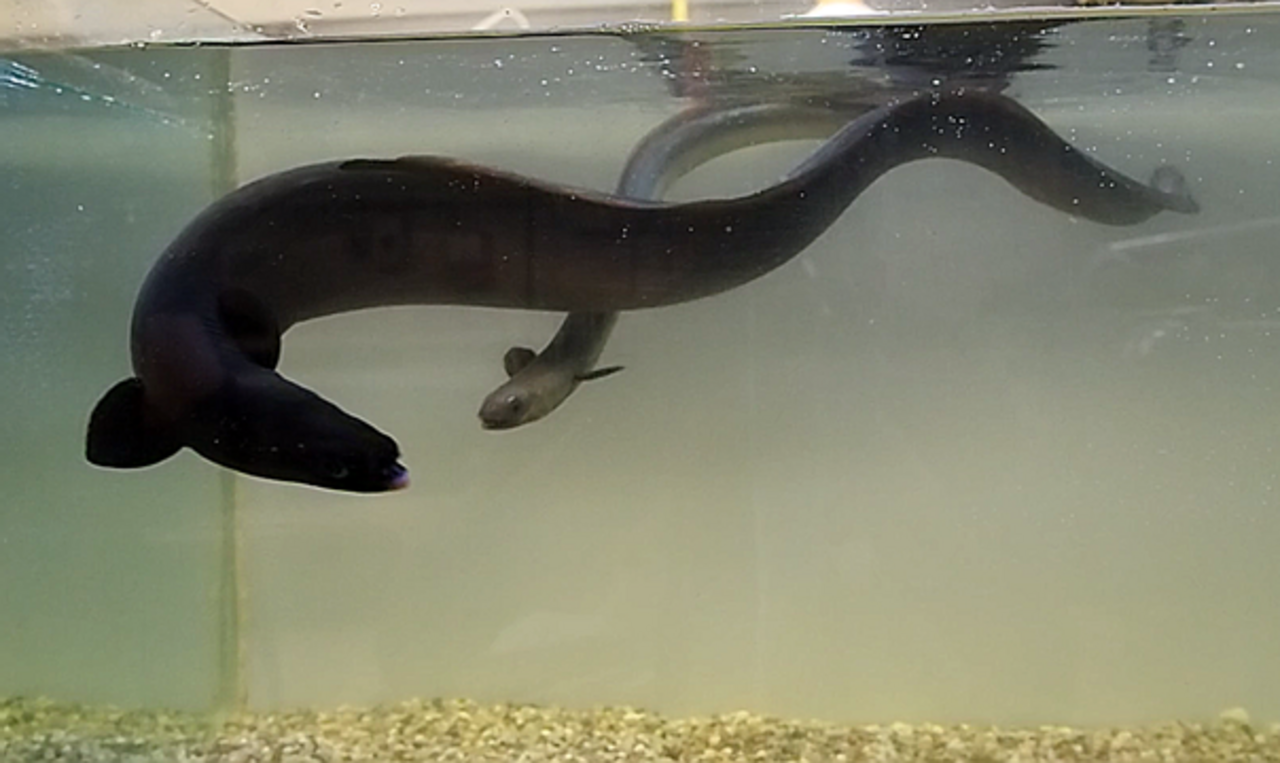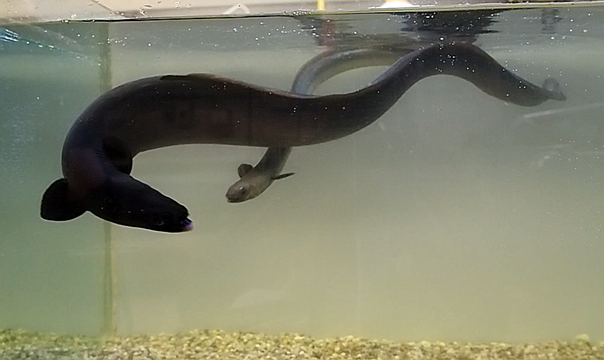Project
Artificial reproduction of the European Eel

Overcoming the difficulties of European eel reproduction. Optimization of artificial maturation, eel husbandry and breeding conditions.
The European eel (Anguilla anguilla) is listed as an endangered species and the current eel fishery is regarded as unsustainable. It is yet not possible to reproduce this species in captivity. Eel aquaculture production relies exclusively on wild caught individuals and does not contribute to a reduction of fishery pressure. In the long term a method to artificially reproduce eels could help to sustainably use the European eel and to support the stock. However, basic difficulties in eel reproduction need to be overcome to achieve this goal.
Background and Objective
The objective of this project is to enhance the artificial reproduction of the European eel (Anguilla anguilla) in Germany. Investigation and development of optimal holding and rearing conditions for eels, eggs and larvae shall enable a permanent production of healthy eel larvae. Holding and rearing facilities are developed in cooperation with Kunststoff-Spranger GmbH, Plauen and in cooperation with the University of Hamburg and BlueBioTech GmbH, Büsum we conduct research on the development of suitable food items for eel larvae.
Approach
The controlled maturation of female and male eels was induced by repeated hormone applications. The effect of different hormones and concentrations on the maturation process was investigated and fertilization and egg incubation procedures were established. Furthermore, artificially produced eggs were tested for contaminants that are potentially toxic for reproduction in order to assess the maternal transfer of these compounds. Satellite transmitters were used to investigate the behaviour of matured female eels in the spawning area.
Our Research Questions
Which holding conditions support the artificial maturation of eels? Which conditions allow the best fertilization success, egg survival and hatching of larvae? Is it possible to feed eel larvae with items based on gelatinous plankton?
Results
The artificial maturation of female and male eels was achieved and successfully synchronized. Eggs were frequently fertilized and the hatch of healthy larvae was reached repeatedly. The life span of single larvae was extended to 23 days. Extenxive feeding trials, however, could not be conducted due to high larvae mortalities. For the first time, the maternal transfer of single contaminants that are potentially toxic for reproduction was shown for the European eel. The results of the behaviour of matured eels in the spawning area are currently analysed.
Involved Thünen-Partners
Involved external Thünen-Partners
-
Universität Hamburg
(Hamburg, Deutschland) -
BlueBioTech GmbH
(Büsum, Deutschland) -
Spranger Kunststoffe GmbH
(Plauen, Deutschland)
Funding Body
-
Federal Office for Agriculture and Food (BLE)
(national, öffentlich)
Duration
2.2014 - 7.2017
More Information
Project funding number: 28-1-73.034-10
Funding program: Innovationsförderung
Project status:
finished
Our Research Questions
Which holding conditions support the artificial maturation of eels? Which conditions allow the best fertilization success, egg survival and hatching of larvae? Is it possible to feed eel larvae with items based on gelatinous plankton?
Results
The artificial maturation of female and male eels was achieved and successfully synchronized. Eggs were frequently fertilized and the hatch of healthy larvae was reached repeatedly. The life span of single larvae was extended to 23 days. Extenxive feeding trials, however, could not be conducted due to high larvae mortalities. For the first time, the maternal transfer of single contaminants that are potentially toxic for reproduction was shown for the European eel. The results of the behaviour of matured eels in the spawning area are currently analysed.
Involved Thünen-Partners
Involved external Thünen-Partners
-
Universität Hamburg
(Hamburg, Deutschland) -
BlueBioTech GmbH
(Büsum, Deutschland) -
Spranger Kunststoffe GmbH
(Plauen, Deutschland)
Funding Body
-
Federal Office for Agriculture and Food (BLE)
(national, öffentlich)
Duration
2.2014 - 7.2017
More Information
Project funding number: 28-1-73.034-10
Funding program: Innovationsförderung
Project status:
finished
Publications
- 0
Freese M, Yokota Rizzo L, Pohlmann J-D, Marohn L, Witten PE, Gremse F, Rütten S, Güvener N, Michael S, Wysujack K, Lammers T, Kiessling F, Hollert H, Hanel R, Brinkmann M (2019) Bone resorption and body reorganization during maturation induce maternal transfer of toxic metals in anguillid eels. PNAS 116(23):11339-11344, DOI:10.1073/pnas.1817738116
- 1
Freese M, Sühring R, Marohn L, Pohlmann J-D, Wolschke H, Byer J, Alaee M, Ebinghaus R, Hanel R (2017) Maternal transfer of dioxin-like compounds in artificially matured European eels. Environ Pollut 227:348-356, DOI:10.1016/j.envpol.2017.04.096
- 2
Marohn L, Hanel R (2017) Untersuchungen zur Aalvermehrung am Thünen-Institut - ein Statusbericht. Mitt Landesforschungsanst Landwirtsch Fischerei Mecklenburg Vorpommern 58:38-41
- 3
Marohn L, Hanel R (2016) Untersuchungen zur Aalvermehrung am Thünen-Institut. Fischer Teichwirt 67(12):444-445
- 4
Sühring R, Freese M, Schneider M, Schubert S, Pohlmann J-D, Alaee M, Wolschke H, Hanel R, Ebinghaus R, Marohn L (2015) Maternal transfer of emerging brominated and chlorinated flame retardants in European eels. Sci Total Environ 530-531:209-218, DOI:10.1016/j.scitotenv.2015.05.094

![[Translate to English:] [Translate to English:]](/media/_processed_/2/9/csm_Embryo-Exp_Gelege_9F_dpf5-200513111619_c8534a8199.jpg)
![[Translate to English:] [Translate to English:]](/media/_processed_/2/9/csm_Embryo-Exp_Gelege_9F_dpf5-200513111619_9027994d44.jpg)










